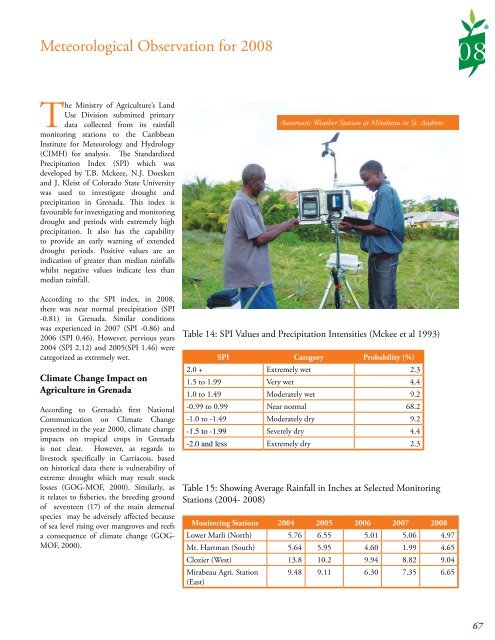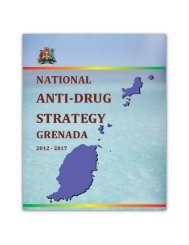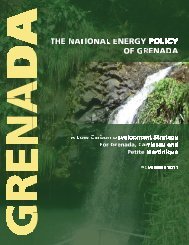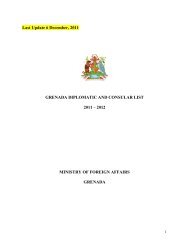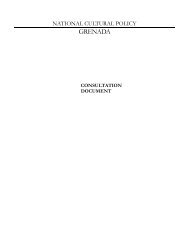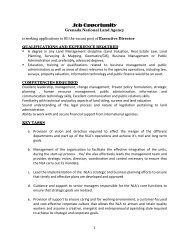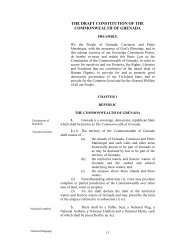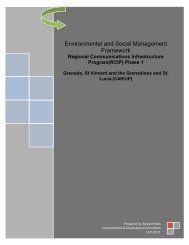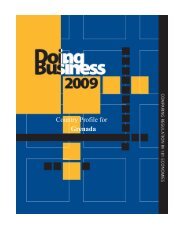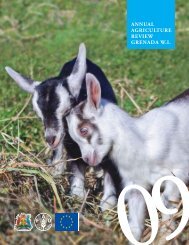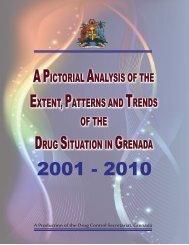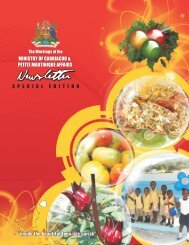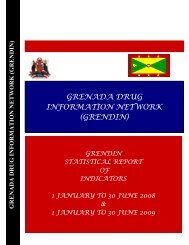Annual Agriculture Review 2008 - Government of Grenada
Annual Agriculture Review 2008 - Government of Grenada
Annual Agriculture Review 2008 - Government of Grenada
You also want an ePaper? Increase the reach of your titles
YUMPU automatically turns print PDFs into web optimized ePapers that Google loves.
Meteorological Observation for <strong>2008</strong><br />
The Ministry <strong>of</strong> <strong>Agriculture</strong>’s Land<br />
Use Division submitted primary<br />
data collected from its rainfall<br />
monitoring stations to the Caribbean<br />
Institute for Meteorology and Hydrology<br />
(CIMH) for analysis. The Standardized<br />
Precipitation Index (SPI) which was<br />
developed by T.B. Mckeee, N.J. Doesken<br />
and J. Kleist <strong>of</strong> Colorado State University<br />
was used to investigate drought and<br />
precipitation in <strong>Grenada</strong>. This index is<br />
favourable for investigating and monitoring<br />
drought and periods with extremely high<br />
precipitation. It also has the capability<br />
to provide an early warning <strong>of</strong> extended<br />
drought periods. Positive values are an<br />
indication <strong>of</strong> greater than median rainfalls<br />
whilst negative values indicate less than<br />
median rainfall.<br />
According to the SPI index, in <strong>2008</strong>,<br />
there was near normal precipitation (SPI<br />
-0.81) in <strong>Grenada</strong>. Similar conditions<br />
was experienced in 2007 (SPI -0.86) and<br />
2006 (SPI 0.46). However, pervious years<br />
2004 (SPI 2.12) and 2005(SPI 1.46) were<br />
categorized as extremely wet.<br />
Climate Change Impact on<br />
<strong>Agriculture</strong> in <strong>Grenada</strong><br />
According to <strong>Grenada</strong>’s first National<br />
Communication on Climate Change<br />
presented in the year 2000, climate change<br />
impacts on tropical crops in <strong>Grenada</strong><br />
is not clear. However, as regards to<br />
livestock specifically in Carriacou, based<br />
on historical data there is vulnerability <strong>of</strong><br />
extreme drought which may result stock<br />
losses (GOG-MOF, 2000). Similarly, as<br />
it relates to fisheries, the breeding ground<br />
<strong>of</strong> seventeen (17) <strong>of</strong> the main demersal<br />
species may be adversely affected because<br />
<strong>of</strong> sea level rising over mangroves and reefs<br />
a consequence <strong>of</strong> climate change (GOG-<br />
MOF, 2000).<br />
Automatic Weather Station at Mirabeau in St. Andrew<br />
Table 14: SPI Values and Precipitation Intensities (Mckee et al 1993)<br />
SPI Category Probability (%)<br />
2.0 + Extremely wet 2.3<br />
1.5 to 1.99 Very wet 4.4<br />
1.0 to 1.49 Moderately wet 9.2<br />
-0.99 to 0.99 Near normal 68.2<br />
-1.0 to -1.49 Moderately dry 9.2<br />
-1.5 to -1.99 Severely dry 4.4<br />
-2.0 and less Extremely dry 2.3<br />
Table 15: Showing Average Rainfall in Inches at Selected Monitoring<br />
Stations (2004- <strong>2008</strong>)<br />
Monitoring Stations 2004 2005 2006 2007 <strong>2008</strong><br />
Lower Marli (North) 5.76 6.55 5.01 5.06 4.97<br />
Mt. Hartman (South) 5.64 5.95 4.60 1.99 4.65<br />
Clozier (West) 13.8 10.2 9.94 8.82 9.04<br />
Mirabeau Agri. Station 9.48 9.11 6.30 7.35 6.65<br />
(East)<br />
67


